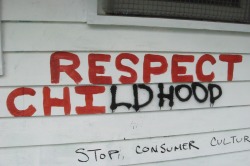a subculture evolved: connecting physical with digital

grandview park public washrooms 2010
Where does graffiti "fit" in digital spaces? How has it evolved in this Internet era? Has the concept of graffiti authorship been altered as a result of the web? What is graffiti as a digital genre? These were some questions that our group came up with after reading Hartling's article on Ch.17 of the textbook. As a group, our focus has been on exploring various aspects of graffiti online and offline, dabbling on history, conventions, social and cultural contexts of graffiti, as well as critically examining graffiti as a digital genre and suggesting some case studies as examples of new phenomena in (web)subcultures.
Graffiti in its recent urban history is a subculture. For my individual creative project, I wanted to experiment with taking this fascinating subculture and transporting it onto the web. The Internet is a medium that transcends physical boundaries, making it possible for a far greater reach between other Internet users -- when applied to graffiti, a normally loosely defined subculture, does this allow for more connections between other artists and graff writers? It did not take me long to find out. While doing preliminary research online, I quickly found an abundance of online communities and website dedicated to all sorts of graffiti. There are online art albums that display graffiti designs and productions, and along with these displays are dialogue between graff artists and writers appreciating, liking, disliking and critiquing each others' works. There are online tools that let people generate their own versions of graffiti digitally. There are also many sites that combine interactive online geo-tagging/mapping technologies maps with photo/video/text to create directories for graffiti found around the world, highlighting the power of collaborative digital works. In effect, the Internet has created a massive arena for a subculture to display their art, whether they are political messages, self-expressions, artistic creations or any other purpose. Graffiti is often a fleeting moment of expression, always being threatened to be gone the next day. Is the Internet a way for this ever-changing art form to become immortalized on digital spaces?
Graffiti in its recent urban history is a subculture. For my individual creative project, I wanted to experiment with taking this fascinating subculture and transporting it onto the web. The Internet is a medium that transcends physical boundaries, making it possible for a far greater reach between other Internet users -- when applied to graffiti, a normally loosely defined subculture, does this allow for more connections between other artists and graff writers? It did not take me long to find out. While doing preliminary research online, I quickly found an abundance of online communities and website dedicated to all sorts of graffiti. There are online art albums that display graffiti designs and productions, and along with these displays are dialogue between graff artists and writers appreciating, liking, disliking and critiquing each others' works. There are online tools that let people generate their own versions of graffiti digitally. There are also many sites that combine interactive online geo-tagging/mapping technologies maps with photo/video/text to create directories for graffiti found around the world, highlighting the power of collaborative digital works. In effect, the Internet has created a massive arena for a subculture to display their art, whether they are political messages, self-expressions, artistic creations or any other purpose. Graffiti is often a fleeting moment of expression, always being threatened to be gone the next day. Is the Internet a way for this ever-changing art form to become immortalized on digital spaces?
my creative project: graffiti on the drive

commercial & venables 2010
It is with this background that I took my "rinky dinky" point-and-shoot digital camera to the Grandview area on Commercial Drive, more fondly referred to as the Drive for many Vancouverites. The Drive is celebrated for its vibrant artistic ambiance, and its multi-national diversities adds to the eclectic atmosphere. Brewing on the flip side, however, are issues such as housing concerns, climbing crime rates and an ever-looming massive urban development takeover. Between everything, this little stretch of the Drive is a perfect breeding ground for graffiti, and this is very apparent every time I visit the area. What makes it even more interesting is that both anonymous, unauthorized graffiti, as well as "legal" community-driven projects and Britannia Bench'n Program wall murals exist around the Drive. I wandered up and down the street, into side streets and back alleys, around parks and garbage bins to collect digital images and note the locations of these displays of public art. I planned to tag an online map with specific locations for each piece of graff art. Easy, I thought.
After finishing the manual labour, I thought the hard part would be over. Boy, was I wrong. It turned out that I would spend much more time scouring the web for the proper mapping applications that looked presentable, was easy-to-use and was free-of-charge. It would take several trial-and-errors to find a site suitable for my purpose, and then many more eye-straining hours to upload, record and tag photos and place them as pin-points on a Google-powered map.
After finishing the manual labour, I thought the hard part would be over. Boy, was I wrong. It turned out that I would spend much more time scouring the web for the proper mapping applications that looked presentable, was easy-to-use and was free-of-charge. It would take several trial-and-errors to find a site suitable for my purpose, and then many more eye-straining hours to upload, record and tag photos and place them as pin-points on a Google-powered map.
